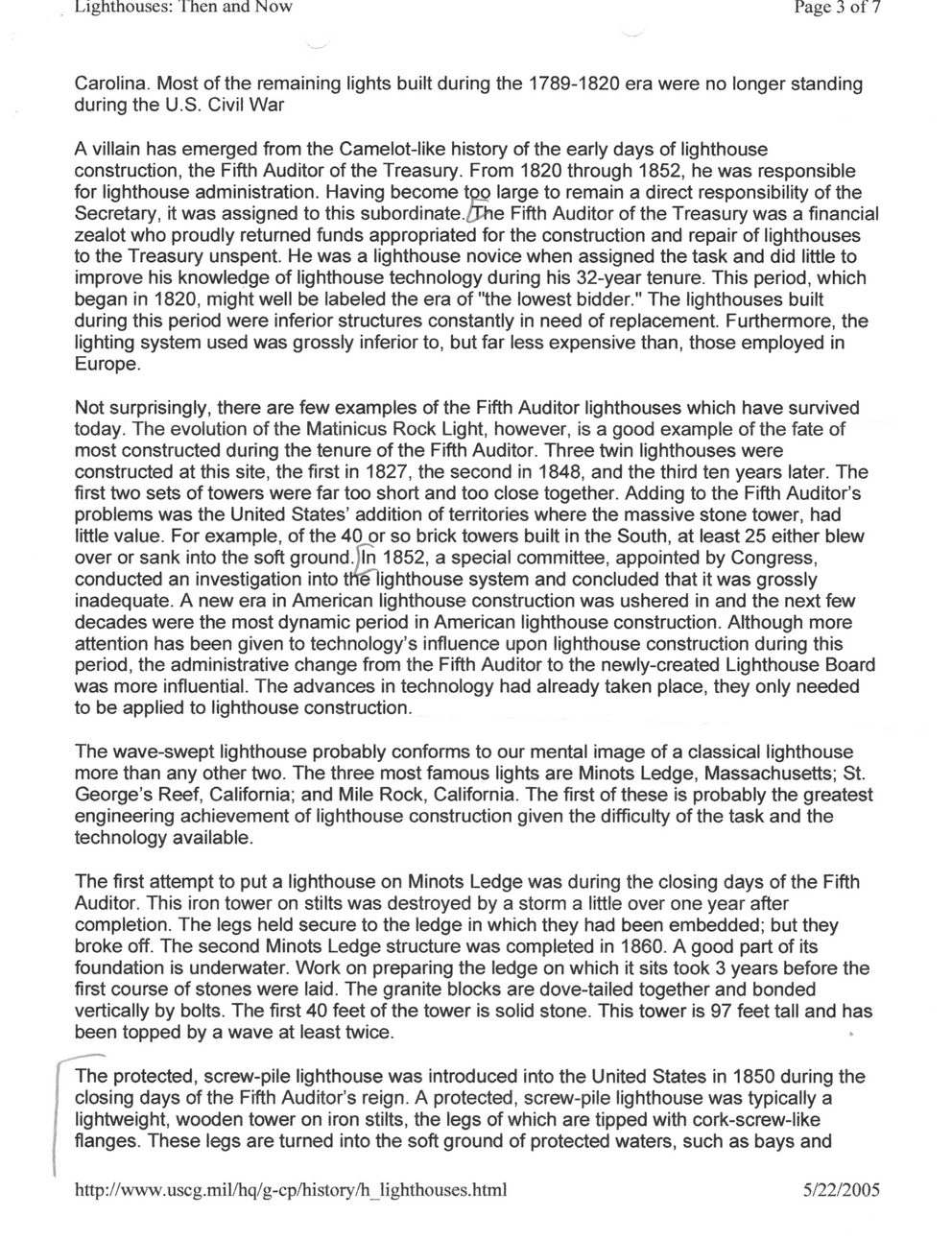This text was obtained via automated optical character recognition.
It has not been edited and may therefore contain several errors.
Lighthouses: Then and Now Page 3 of 7 Carolina. Most of the remaining lights built during the 1789-1820 era were no longer standing during the U.S. Civil War A villain has emerged from the Camelot-like history of the early days of lighthouse construction, the Fifth Auditor of the Treasury. From 1820 through 1852, he was responsible for lighthouse administration. Having become top large to remain a direct responsibility of the Secretary, it was assigned to this subordinate.^he Fifth Auditor of the Treasury was a financial zealot who proudly returned funds appropriated for the construction and repair of lighthouses to the Treasury unspent. He was a lighthouse novice when assigned the task and did little to improve his knowledge of lighthouse technology during his 32-year tenure. This period, which began in 1820, might well be labeled the era of "the lowest bidder." The lighthouses built during this period were inferior structures constantly in need of replacement. Furthermore, the lighting system used was grossly inferior to, but far less expensive than, those employed in Europe. Not surprisingly, there are few examples of the Fifth Auditor lighthouses which have survived today. The evolution of the Matinicus Rock Light, however, is a good example of the fate of most constructed during the tenure of the Fifth Auditor. Three twin lighthouses were constructed at this site, the first in 1827, the second in 1848, and the third ten years later. The first two sets of towers were far too short and too close together. Adding to the Fifth Auditor’s problems was the United States’ addition of territories where the massive stone tower, had little value. For example, of the 40 or so brick towers built in the South, at least 25 either blew over or sank into the soft ground.jfn 1852, a special committee, appointed by Congress, conducted an investigation into tfrelighthouse system and concluded that it was grossly inadequate. A new era in American lighthouse construction was ushered in and the next few decades were the most dynamic period in American lighthouse construction. Although more attention has been given to technology’s influence upon lighthouse construction during this period, the administrative change from the Fifth Auditor to the newly-created Lighthouse Board was more influential. The advances in technology had already taken place, they only needed to be applied to lighthouse construction. The wave-swept lighthouse probably conforms to our mental image of a classical lighthouse more than any other two. The three most famous lights are Minots Ledge, Massachusetts; St. George’s Reef, California; and Mile Rock, California. The first of these is probably the greatest engineering achievement of lighthouse construction given the difficulty of the task and the technology available. The first attempt to put a lighthouse on Minots Ledge was during the closing days of the Fifth Auditor. This iron tower on stilts was destroyed by a storm a little over one year after completion. The legs held secure to the ledge in which they had been embedded; but they broke off. The second Minots Ledge structure was completed in 1860. A good part of its foundation is underwater. Work on preparing the ledge on which it sits took 3 years before the first course of stones were laid. The granite blocks are dove-tailed together and bonded vertically by bolts. The first 40 feet of the tower is solid stone. This tower is 97 feet tall and has been topped by a wave at least twice. The protected, screw-pile lighthouse was introduced into the United States in 1850 during the closing days of the Fifth Auditor’s reign. A protected, screw-pile lighthouse was typically a lightweight, wooden tower on iron stilts, the legs of which are tipped with cork-screw-like flanges. These legs are turned into the soft ground of protected waters, such as bays and http://www.uscg.mil/hq/g-cp/history/h_lighthouses.html 5/22/2005

Lighthouses Chronology-of-Aids-to-Navigation-(03)-(1)